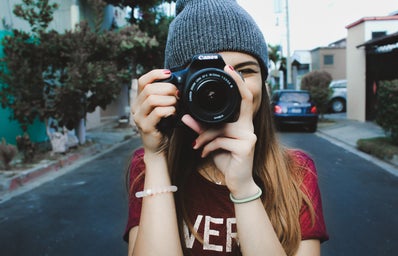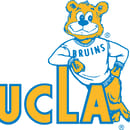Zhenya Gershman’s latest exhibition, Days of Awe, will be featured at Hillel at the University of California, Los Angles (UCLA) until December 17. The opening exhibition reception is free and will be held on Tuesday, October 26 from 7-9pm. In my exclusive interview with Gershman, I got to learn more about her and her art.
Her Campus: How did you start making art?
Zhenya Gershman: I was born in Moscow, Russia where there was a shortage of everything, especially the art materials. My parents were somehow able to get wallpaper, and this was a big thing to have at the time. I doodled drawings all over it because I thought it was a beautiful surface. I was three years old; somehow kids know what their destiny is. My first conscious effort was when I was ten and I was so moved by a film called “Mephisto,” about an artist’s quest of self expression and the demon within him. This concept of an artist filled me like never before. I ran to my room, grabbed some markers and drew this flying creature which was this demon the artist plays.
HC: When and why did you come to the US?
ZG: We came just before the Soviet Union collapsed in 1991. We left one country, but when we came to America that country didn’t exist anymore. We left in search of freedom and independence. At the time, it was difficult to be an artist, to be Jewish, to be a human being. My mom wanted me to live in a place where I had the freedom to paint whatever I wanted.
HC: You were the youngest student to be admitted to Otis Art Institute, and later received your Masters of Fine Arts degree from Art Center College of Design. Can you tell me a little about your experiences at both schools?
ZG: At Otis, a lot of the student’s artwork involved them trying to understand themselves and fashioning themselves to how they act in the world. But my concept of an artist was really about what kind of art I was making. I was determined to paint. At the time of the 90’s conceptual art was at its peak, and there was this concept that everything is dead, that art is dead, and everything is intellectual. But I was able to navigate through the system and found amazing professors who believed in materials, traditions and passing on this secret craft that will die if you don’t practice it. Art Center was very difficult to get into. They only accept five painters from the entire world each year. It was being both a student and a professional artist at the same time. Otis was about people trying to find their identity, Art Center was: “okay now what are you going to do with your art.”
HC: What inspires you and what are you trying to communicate with your art?
ZG: What inspires me is humanity and human contact. I am always painting for someone, not myself. My work is in conversation with someone out there who I believe will listen, who will be inspired and who will answer my question. By answering my question, they will be able to complete the work and be able to change it. The real goal is that people who aren’t born yet will be able to talk to me through my art. It’s really all about connection for me.
HC: Please tell me more about how the High Holidays inspired your latest exhibition, Days of Awe. What are you trying to communicate with this exhibition?
ZG: I always say that I don’t practice religion, I practice art. Art for me is a form of spirituality, and connecting to something larger. I was invited by UCLA Hillel to have an exhibition that will be hanging during the high holidays. In the religion, the Ten Days of Awe is about the prayer and connection to God, but I saw it as connecting with yourself, as a time of retrospection, and that’s what art is for me is. During these Ten Days of Awe, you’re supposed to meditate about humanity and how you are connected to others, where you missed those connections, where those connections went wrong and how in return you mistreated yourself because when you mistreat others, you rob yourself of something. It’s connected to religion and God, but it’s so much more about the relationships and being human. These paintings are about soul finding, humanity, touch and restoring the balance. I created this work so that people will become aware of their own bodies and the bodies of the people next to them— where the compassion comes in. These paintings are made for everyone, even though they are in a Jewish building for services, they’re meant to be universal.
HC: How might college students relate to your exhibition?
ZG: That’s a good question for you, what do you think?
HC: College can be a really overwhelming time. I think the idea of self reflection is key. Sometimes we need to take a step back to reflect on what we believe is really important. We are also so invested in technology from social media to dating apps (like Tinder). Your emphasis on human connection is really important for college students. I think we need to put our phones aside and make real human connections, to be in the moment.
ZG: I also hope students can look at my art and feel that mistakes are okay because you can change and undo things; when you make those changes the world becomes really beautiful.
HC: What’s the best piece of advice you have been given?
ZG: A very famous Jewish artist, Chaim Gross, told me that one of the best things you can do as an artist is not making art. He said “once you’re an artist, you’re always making art by your experiences, that the living time is more important than the making.”
HC: Do you have any words of wisdom for college women interested in a career in the creative industry?
ZG: My biggest words of wisdom are to say that you are already an expert. You don’t need to say that you don’t have the tools or the wisdom. What matters is that you are a human being. Art is not made for professors or the rich and famous, it’s made for those who are willing to open up and connect.
Want to learn more about Gershman? Check out her nonprofit, Project Awe, and watch her documentary, “The Model’s Artists.”
Photos couresty of Gershman from Days of Awe: “Laughter in the Dark,” “Graven,” and “Axis Mundl”


